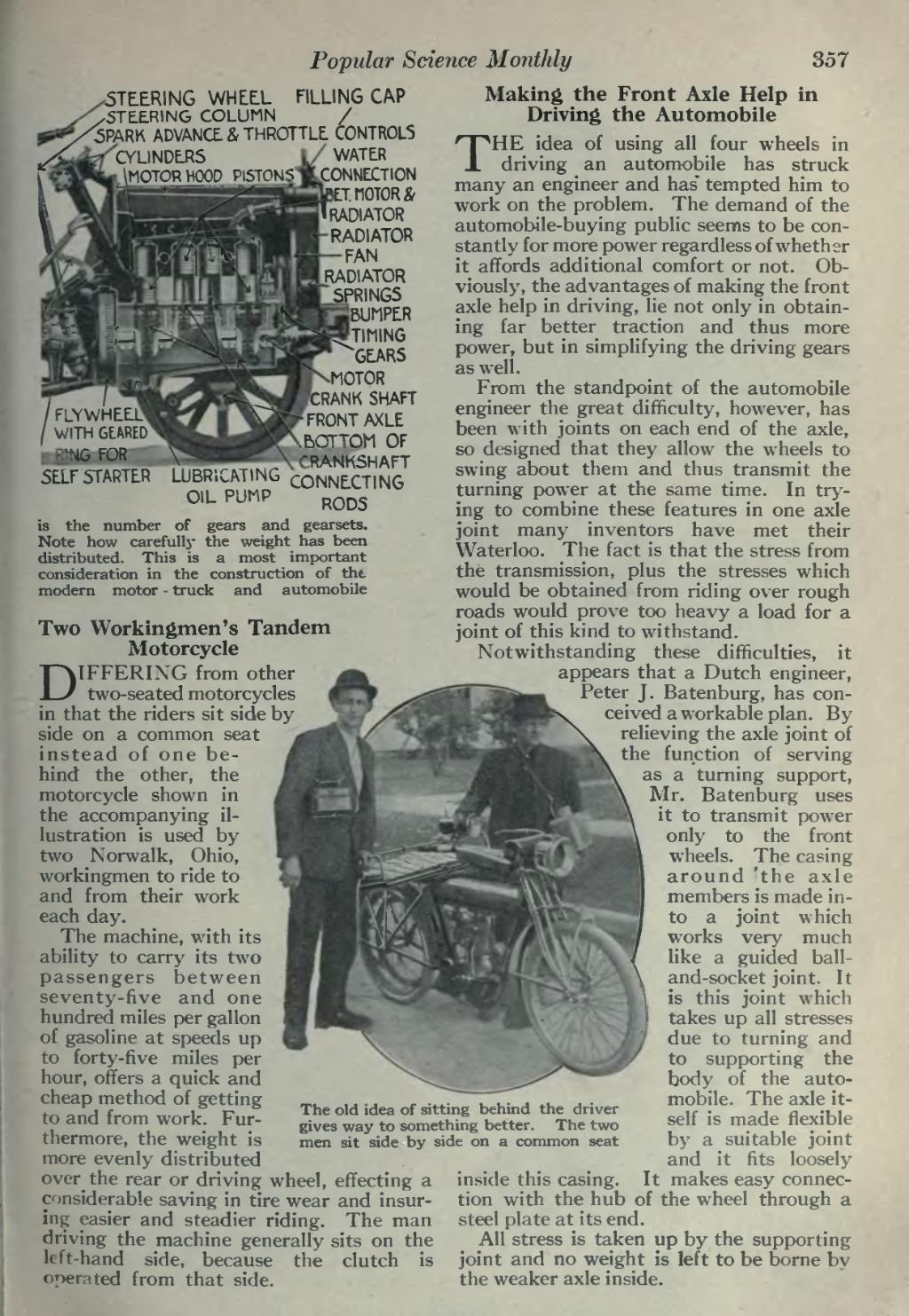Popular Science Monthly
��357
��-STEERING WHEEL FILLING CAP STEERING COLUMN /
3pARK ADVANa & THROTTLE. CONTROLS
WATER (CONNECTION ETnOTOR& RADIATOR RADIATOR
FAN RADIATOR SPRINGS BUMPER TIMING GEARS MOTOR 'CRANK SHAFT FRONT AXLE BOTTOM OF CRANKSHAFT
���FLYWHEEL^ WITH GLARED - RING FOR SELF STARTER
��LUBRICATING CONNECTING OIL PUMP j,op5
is the number of gears and gearsets. Note how carefuUj- the weight has been distributed. This is a most important consideration in the construction of tht modern motor - truck and automobile
Two Workingmen's Tandem Motorcycle
DIFFERING from other two-seated motorcycles in that the riders sit side by side on a common seat instead of one be- hind the other, the motorcycle shown in the accompanying il- lustration is used by two Norwalk, Ohio, workingmen to ride to and from their work each day.
The machine, with its ability to carry its two passengers between seventy-five and one hundred miles per gallon of gasoline at speeds up to forty-five miles per hour, offers a quick and cheap method of getting to and from work. Fur- thermore, the weight is more evenly distributed over the rear or driving wheel, effecting a considerable saving in tire wear and insur- ing easier and steadier riding. The man driving the machine generally sits on the left-hand side, because the clutch is operated from that side.
��Making the Front Axle Help in Driving the Automobile
THE idea of using all four wheels in driving an automobile has struck many an engineer and has' tempted him to work on the problem. The demand of the automobile-buying public seems to be con- stantly for more power regardless of whether it affords additional comfort or not. Ob- viously, the advantages of making the front axle help in driving, lie not only in obtain- ing far better traction and thus more power, but in simplifying the driving gears as well.
From the standpoint of the automobile engineer the great difficulty, however, has been with joints on each end of the axle, so designed that they allow the wheels to swing about them and thus transmit the turning power at the same time. In try- ing to combine these features in one axle joint many inventors have met their Waterloo. The fact is that the stress from the transmission, plus the stresses which would be obtained from riding over rough roads would prove too heavy a load for a joint of this kind to withstand.
Notwithstanding these difficulties, it appears that a Dutch engineer, Peter J. Batenburg, has con- ceived a workable plan. By relieving the axle joint of the function of serving as a turning support, Mr. Batenburg uses it to transmit power only to the front wheels. The casing around 'the axle members is made in- to a joint which works very much like a guided ball- and-socket joint. It is this joint which takes up all stresses / due to turning and to supporting the body of the auto- mobile. The axle it- self is made flexible by a suitable joint and it fits loosely It makes easy connec- tion with the hub of the wheel through a steel plate at its end.
All stress is taken up by the supporting joint and no weight is left to be borne by the weaker axle inside.
���The old idea of sitting behind the driver gives way to something better. The two men sit side by side on a common seat
��inside this casing.
�� �
